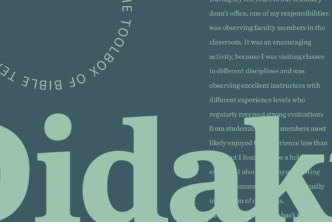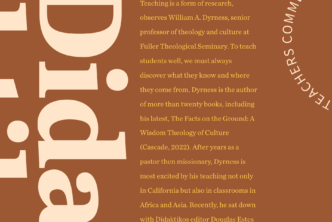Biblical performance criticism is a methodology based on the assumption that much of the literature collected in the Bible represents oral performances that were at one time either told from memory or presented as prepared readings before audiences.1 The performance critic studies the biblical writings as oral performances with the aim to uncover certain conventions of orally performed texts—features often neglected when employing other biblical critical methodologies.
Evidence suggests that ancient recitations were highly expressive, engaging, dramatic, relational, vocal, and dynamic (cf. Isocrates, Phil. 5.25–27; Cicero, De or. 25–27; Suetonius, Poet., Vita Verg. 28–30). They were a heightened form of communication. Certain Old Testament prophets communicated dramatically, utilizing an array of gestures and actions to enhance their message (e.g., Ezek 24; Jer 19; Isa 20). Also pointing to original dramatic performances are the various poetic features present in many biblical genres such as alliteration and onomatopoeia—poetic features primarily enjoyed when heard spoken out loud.
Part of the approach of biblical performance criticism is to look for performance features and oral attributes that may be embedded in the biblical text. These features and attributes suggest how the passage might have been performed or recited in antiquity. I have found that teaching students to examine a passage for these oral conventions can achieve multiple pedagogical goals in graduate and undergraduate Bible courses. First, it provides an opportunity for the instructor to model the approach to students. Second, it can be undertaken as a group assignment, thereby promoting student-to-student interaction. Third, it stimulates active student engagement with the course content and assists them in mastering some portion of a course’s learning outcomes. Fourth, the methodology fosters a close reading of the text, something important to good biblical interpretation. Finally, because biblical performance criticism interacts with existing methodologies, using it in the classroom also provides students a chance to practice other approaches such as rhetorical criticism and narrative criticism.
A biblical text may exhibit a wide range of potential performance features and oral attributes.2These can indicate vocal modulation such as pace, tone, volume, emphasis, rhythm, and opportunities for character or author personification. They also can provide clues of dramatic gestures that might have accompanied the recitations. Once the method is explained to students, they can examine an assigned passage to determine if the features and oral attributes are present.
PACE, TONE, VOLUME, AND EMPHASIS
Sometimes the speed of a recitation can be implied in a passage. For example, if people are hurrying, the reading speed may be increased. In Luke’s version of the parable of the banquet (Luke 14:15–24), Jesus shares the incredible news that the messianic feast is present in the here and now. At different points in the narrative, three words—ἤδη (ēdē; at once; 14:17), ταχέως (tacheōs; quickly; 14:21), and ἀνάγκασον (anankason; compel; 14:23)—convey the urgency of inviting people to the banquet and responding to the invitation. Speeding up the delivery may be able to capture the sense of urgency emphasized in the parable. In Isaiah 40:3, assonance and alliteration combine ( קוֹל קוֹרֵא , qôl qôrē ʼ; “a voice cries out”) to emphasize a loud shout.
REPETITION OF WORDS AND PHRASES
In oral communication, repeated words and phrases create a sense of rhythm. This is evident in the recurring phrase “And God said, let there be” in Genesis 1. According to Susan Niditch, the repeated phrase gives the impression of “a magisterial and in-charge deity whose word is all powerful.”3 This characterization of God can be communicated through various vocal modifications each time the phrase is spoken.
CHARACTER OR AUTHOR PERSONAS
Impersonation was a tool of ancient orators (Demetrius, Eloc. 265–66) and lawyers in court as they delivered their speeches as a defense or prosecuting attorney (Cicero, Cael. 33–38; Quintilian, Inst. 9.2.30–37). The reader performing a biblical narrative could impersonate characters through various means, including, but not limited to, consideration of the person’s age, sex, and social status. For instance, persons of high social standing such as kings and other authoritative figures will speak in a stately manner, whereas the poor, sick, and marginalized will have a much different expression. How might they be distinguished from the other characters? How does one present God as the one speaking? Will his words be spoken in a deep voice or with a whisper, which finds some biblical support (1 Kgs 19:12)?
A reader may also impersonate the author’s voice depending on the mood or content of the manuscript. For example, a reader might have imitated Paul’s reference to his advanced age by slowing down the tempo of his speech and using a tremulous voice (e.g., Phlm 9).
EMOTIONAL LANGUAGE
Emotions are potential clues for a speaker to modify his voice in accordance with the mood being expressed. Emotive language can be direct or indirect. Direct emotional language is indicated when emotional words (e.g., hope, fear, jealousy, anger) are specifically mentioned in the text. An example of language carrying indirect but no less forcible emotive feelings is the sentence “the boy fell asleep and never woke up again.” The unpleasant emotion is not explicitly stated, but the sentence triggers negative, depressed feelings—because the emotion is implied. Thus, in addition to the direct mention of emotions, context can indicate a passionate situation. For example, David’s lament over the death of his son Absalom has the phrase “O my son Absalom” spoken repeatedly (2 Sam 18:32; 19:4). In this passage, a skilled reader will express a range of emotions such as shock, grief, tenderness, anger, longing, regret, and maybe self-blame.4
Expressive content also can be conveyed through striking imagery, which was intended to create an emotion that will be remembered. Biblical authors often utilized image-based techniques to evoke an audience’s “visualization” of the text. For example, Joshua is described wearing clothing stained with excrement, representative of his guilt and sin (Zech 3:3). How would you imagine those lines being spoken to convey the disgust present in the imagery? It is helpful to visualize the imagery when you speak emotional words.
References to the body can suggest a variety of emotions. In oral and written literature an author can describe various actions and thereby indicate certain emotions. Contempt and separation are indicated in Scripture by shaking the dust off one’s feet (Matt 10:14; Acts 13:51). Shame is shown by putting the hand on the mouth and vowing to not speak again (Job 40:4–5). Putting one’s face to the ground or bowing is an act of obeisance (e.g., 1 Sam 24:8; 28:14; 2 Sam 14:33). This is only a sample of the many other gestures mentioned in the Bible.
The task of discovering the feelings expressed in a passage can be facilitated by marking up the text, making notations of the emotions present and even asking what each sentence or phrase is doing by assigning it an action.5 What is the purpose of the sentence? Is it aiming to inform, instruct, assure, inspire, exhort, persuade, praise, comfort, entertain, or achieve a combination of two or more of these purposes? If the text is emotive, is it trying to evoke pleasure, pain, hope, contentment, fear, joy, gratitude, or any combination of these emotions? For example, in Romans 8:1, when Paul says “There is therefore now no condemnation for those who are in Christ Jesus,” one might include the following comment: Paul is trying to assure, to evangelize, to relieve guilt.6 Thus, what tone of voice would be appropriate to assist Paul in accomplishing these tasks?
RHETORICAL DEVICES
Certain rhetorical devices such as rhetorical questions and asyndeton can affect the vocalization of a text. For example, rhetorical questions can serve to express the emotion of the speaker (Quintilian, Inst. 9.2.7–11). Asyndeton is a figure of speech that affects the delivery of a text through suppressing or omitting conjunctions in separate parts of a sentence (Quintilian, Inst. 9.3.50; Rhet. Her. 4.30). The initial portion of the Lord’s Prayer omits connecting particles between each of the phrases, which in succession request the sanctifying of God’s name, the coming of his kingdom, and the accomplishment of his will (Matt 6:9–10). The exclusion of conjunctions gives the impression of haste when spoken, perhaps suggesting a desire by the supplicant for a quickening of the Lord’s return.
ANALYSIS, SCRIPT, AND PERFORMANCE
Once these features and attributes have been explained to students and you have modeled the methodology, provide them with a selected passage in which they can look for any of the features and oral attributes previously discussed. Familiarity with the original languages will determine which features and attributes students might discover. From the student’s analysis of the oral features of the text, they should mark up a script with the goal of communicating these vocal attributes in a modern language. Have someone from each group read the translation, employing the modifications. I have found this exercise to be more successful after having become acquainted with the students, being aware of those who are more participatory in class discussions. Make sure to place one of these more outgoing students in each group, as they will likely be more willing to dramatize their script in front of their peers. Following each group’s reading, solicit feedback from the rest of the class.
For many ancient written texts to be fully understood, hearing the voice of a reader is crucial. Practicing biblical performance criticism in the classroom helps accomplish this realization for Christianity’s sacred texts.
DAVID SEAL is currently coauthoring a popular-level book titled Performing Scripture (Grove Books).
This article was originally published in Didakitkos: Journal of Theological Education. Sign up for free today.

- For a more extensive discussion of biblical performance criticism see David Rhoads, “Performance Criticism (Biblical),” in The Dictionary of the Bible and Ancient Media, ed. Tom Thatcher et al. (London: Bloomsbury, 2017), 281–89; David Seal and Michael Partridge, Performing Scripture (Cambridge: Grove, forthcoming).
- More complete discussions of these features in New Testament literature can be found in Whitney Shiner, Proclaiming the Gospel: First–Century Performance of Mark (Harrisburg, PA: Trinity Press International, 2003); Bernard Oestreich, Performance Criticism in the Pauline Letters, Biblical Performance Criticism 14, ed. David Rhoads, Holly E. Hearon, and Kelly R. Iverson, trans. Lindsay Elias and Brent Blum (Eugene, OR: Cascade, 2016). For oral performance features in the Old Testament literature see Susan Niditch, Oral World and Written Word, Library of Ancient Israel, ed. Douglas A. Knight (Louisville: Westminster John Knox, 1996); Robert D. Miller II, Oral Tradition in Ancient Israel, Biblical Performance Criticism 4 (Eugene, OR: Cascade, 2011).
- Niditch, Oral World, 11.
- Grenville J. R. Kent, “Vocal Exegesis: Reading Scripture Publicly without the Heresy of Boredom,” Southeastern Theological Review 5 (2014): 47–59, here 51.
- Kent, “Vocal Exegesis,” 52.
- Kent, “Vocal Exegesis,” 53.





